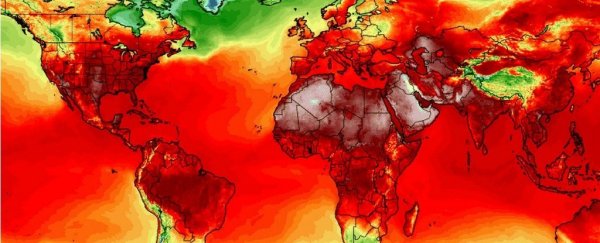The United Nations Secretary-General has called 2021 "the make it or break it year" for climate action.
2021 is not over yet, but a provisional report on the state of the planet suggests we are leaning heavily towards breaking it.
Experts at the UN's World Meteorological Organization (WMO) recently calculated the last seven years have been the warmest on record.
We only have data for the first nine months of 2021, but the initial analysis suggests it will likely rank either the fifth, sixth, or seventh warmest year of those seven.
The main reason it won't be warmer is because earlier this year, the cooling effects of La Niña kicked in.
The trend since 2015, however, is clear: In just seven years, there has been a rapid and long-term rise in global temperatures, sea level rise, ocean warming, and acidification.
At the current rate of greenhouse gas emissions, the report calculates the world will warm by at least 1.5 to 2 degrees Celsius come the end of the century.
The global mean temperature from January to September 2021 was already about 1.09 °C above the pre-industrial average, which means we don't have much wiggle room left.
"We are still significantly off-schedule to meet the goals of the Paris Agreement. This year has seen fossil fuel emissions bounce back, greenhouse gas concentrations continuing to rise and severe human-enhanced weather events that have affected health, lives and livelihoods on every continent," wrote the UN Secretary-General, Antonio Guterres, in a foreword for the report.
"Unless there are immediate, rapid and large-scale reductions in greenhouse gas emissions, limiting warming to 1.5 °C will be impossible, with catastrophic consequences for people and the planet on which we depend."
The report was released at the start of the UN Climate Change negotiations, currently being held in Glasgow, Scotland. Known as COP26 for short, the conference will ultimately decide how the world will progress in this pivotal moment, so it's important we know where we're at.
The snapshot provided by the WMO report, which is considered a flagship scientific document, is alarming on pretty much every level.
In 2020, despite a global pandemic which briefly slowed emissions, the report reveals greenhouse gas concentrations in the atmosphere hit all new highs. Carbon dioxide had increased 150 percent since pre-industrial levels, methane had increased 262 percent, and nitrous oxide 123 percent.
Climate data from the start of 2021 suggest this year saw a slight dip from La Niña, but compared to the last La Niña event in 2011, this year also appears significantly warmer.
Given rising global temperatures across the board, even years of La Niña, it's no surprise that sea ice in the East Greenland Sea hit a record low this year. But it's still shocking.
In August, researchers recorded the first-ever rainfall on the summit of the Greenland Ice Sheet, and it lasted for hours. Usually, this summit only ever receives snow.
In the ocean, things aren't much better. Warming, sea level rise and acidification are steadily worsening with time.
The report found ocean acidification hasn't been at this level for at least 26,000 years, and it's impacting the ocean's ability to store carbon dioxide from the atmosphere, making the climate crisis above the waves even worse.
"From the ocean depths to mountain tops, from melting glaciers to relentless extreme weather events, ecosystems and communities around the globe are being devastated," warns Guterres.
"COP26 must be a turning point for people and planet."
In the past nine months, the world has experienced numerous wildfires, several extreme heat waves, cyclones, hurricanes, droughts, and some severely cold weather events, too.
In Bangladesh, monsoon rains were so bad this summer, several refugee sites were flooded, displacing more than 25,000 people who had already lost their homes before.
We must build back better
Emerging research suggests climate change will only make extreme weather events like these more frequent and severe.
"Months' worth of rainfall fell in the space of hours in China, and parts of Europe saw severe flooding, leading to dozens of casualties and billions in economic losses," recalls WMO Secretary-General Petteri Taalas.
"A second successive year of drought in sub-tropical South America reduced the flow of mighty river basins and hit agriculture, transport and energy production. Extreme events are the new norm."
Taalas argues nations not only need to significantly cut their emissions, but also prepare for the realities ahead that are already locked in. Investing in climate adaptation is one of the best ways to save lives and livelihoods from extreme weather events in the future, he says.
"Throughout the pandemic we have heard that we must build back better to set humanity on a more sustainable path and to avoid the worst impacts of climate change on society and economies," continues Taalas.
"This report shows that so far in 2021 we are not going in the right direction."
Here's to hoping leaders at COP26 can turn this ship around.
The WMO provisional report can be easily read in the form of a story map.
